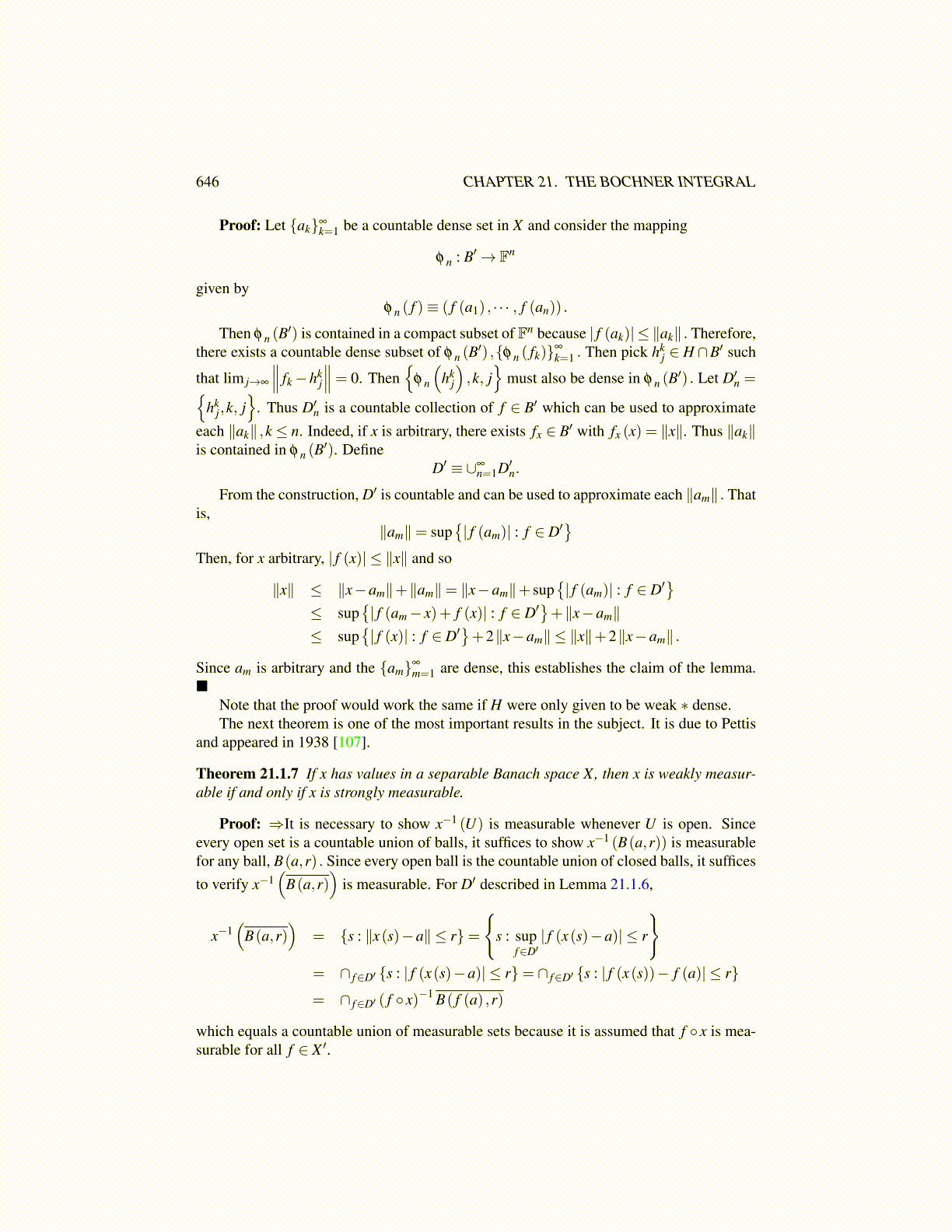
646 CHAPTER 21. THE BOCHNER INTEGRAL
Proof: Let {ak}∞k=1 be a countable dense set in X and consider the mapping
φ n : B′→ Fn
given byφ n ( f )≡ ( f (a1) , · · · , f (an)) .
Then φ n (B′) is contained in a compact subset of Fn because | f (ak)| ≤ ∥ak∥ . Therefore,
there exists a countable dense subset of φ n (B′) ,{φ n ( fk)}∞
k=1 . Then pick hkj ∈ H ∩B′ such
that lim j→∞
∥∥∥ fk−hkj
∥∥∥= 0. Then{
φ n
(hk
j
),k, j
}must also be dense in φ n (B
′) . Let D′n ={hk
j,k, j}
. Thus D′n is a countable collection of f ∈ B′ which can be used to approximate
each ∥ak∥ ,k ≤ n. Indeed, if x is arbitrary, there exists fx ∈ B′ with fx (x) = ∥x∥. Thus ∥ak∥is contained in φ n (B
′). DefineD′ ≡ ∪∞
n=1D′n.
From the construction, D′ is countable and can be used to approximate each ∥am∥ . Thatis,
∥am∥= sup{| f (am)| : f ∈ D′
}Then, for x arbitrary, | f (x)| ≤ ∥x∥ and so
∥x∥ ≤ ∥x−am∥+∥am∥= ∥x−am∥+ sup{| f (am)| : f ∈ D′
}≤ sup
{| f (am− x)+ f (x)| : f ∈ D′
}+∥x−am∥
≤ sup{| f (x)| : f ∈ D′
}+2∥x−am∥ ≤ ∥x∥+2∥x−am∥ .
Since am is arbitrary and the {am}∞
m=1 are dense, this establishes the claim of the lemma.
Note that the proof would work the same if H were only given to be weak ∗ dense.The next theorem is one of the most important results in the subject. It is due to Pettis
and appeared in 1938 [107].
Theorem 21.1.7 If x has values in a separable Banach space X, then x is weakly measur-able if and only if x is strongly measurable.
Proof: ⇒It is necessary to show x−1 (U) is measurable whenever U is open. Sinceevery open set is a countable union of balls, it suffices to show x−1 (B(a,r)) is measurablefor any ball, B(a,r) . Since every open ball is the countable union of closed balls, it sufficesto verify x−1
(B(a,r)
)is measurable. For D′ described in Lemma 21.1.6,
x−1(
B(a,r))
= {s : ∥x(s)−a∥ ≤ r}=
{s : sup
f∈D′| f (x(s)−a)| ≤ r
}= ∩ f∈D′ {s : | f (x(s)−a)| ≤ r}= ∩ f∈D′ {s : | f (x(s))− f (a)| ≤ r}
= ∩ f∈D′ ( f ◦ x)−1 B( f (a) ,r)
which equals a countable union of measurable sets because it is assumed that f ◦ x is mea-surable for all f ∈ X ′.